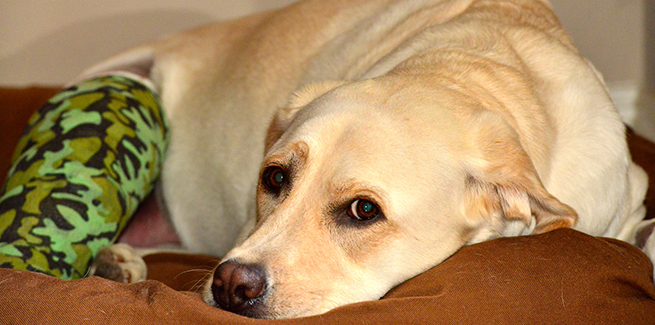Study: There may be a biomarker for canine osteoarthritis—and it involves cranial cruciate ligaments

Lubricin is a protein that lubricates joints in both animals and humans, and research has indicated that an absence of lubricin can be a precursor to joint disease. But a new study out of Cornell suggests that the presence of lubricin might actually be a predictor of osteoarthritis.
An injury to the anterior cruciate ligament (ACL) can lead to severe osteoarthritis in humans; the same holds true for injuries to the cranial cruciate ligament (CCL) in quadrupeds.
The study, published October 7 in Scientific Reports, is the first to investigate the role of lubricin in CCL injuries in dogs.
“Lubricin is crucial for normal joint function and the lubrication of cartilage,” said Heidi Reesink, PhD, an assistant professor in equine health at the Cornell College of Veterinary Medicine and senior author on the paper. “We know that if a person or animal doesn’t make that protein, they will develop devastating joint disease, affecting all the major weight-bearing joints.”
The researchers found that in canine patients who had suffered a CCL rupture, lubricin increased within the joint—the opposite of conventional assumptions in medicine.
In three canine patients who had a joint injury, lubricin increased dramatically after their initial injury but before their X-rays showed any signs of arthritis.
“This indicates that the presence of increased lubricin might actually be a biomarker for predicting future osteoarthritis,” said Reesink. “We also saw increased lubricin in dogs months to years after they injured their CCLs, suggesting that lubricin might be an indicator of ongoing joint instability.”
The researchers prepared for the new study by completing a systematic review of the literature surrounding lubricin in both human and veterinary medicine. The review was published in May in the journal Osteoarthritis and Cartilage.
The overall finding of that review found no unified consensus on how lubricin is altered in other domestic veterinary species and in human joint injury, demonstrating the need for further study—which led to the new study.
The research was inspired in part by the high number of cases of CCL injuries presented at the Cornell University Hospital for Animals.
“We can help both animals and humans by potentially coming up with better diagnostics, by more fully understanding how these molecules work, and designing therapies beneficial to both by taking advantage of these naturally occurring cases and improving orthopedic care,” Reesink said.
The researchers plan to do a follow-up longitudinal study in dogs, examining multiple time points in a patient’s injury, treatment, and recovery process. They also hope to draw similar connections in human ACL and other orthopedic injuries.
Photo credit: © mauinow1/iStock/Getty Images Plus via Getty Images



